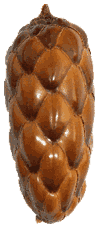 |
Palm |
 |
Palm |
Balaka macrocarpa is endemic to Fiji, part of the Polynesia-Micronesia Hotspot. In Fiji, it is know from three widely separate populations, one on the island of Viti Levu, one from the foothills of Mt. Sorolevu, on Vanua Levu, and another from the Natewa Peninsula (also known as the Cakaudrove or Tunuloa Peninsula) of Vanua Levu. The Natewa Peninsula population is a historical record and has not be visited in recent years. This palm is an understory palm of wet forests at 200–400 m elev. It is reported to be locally common on slopes in undesturbed forests.
Balaka macrocarpa is one of six taxa believed to be present in Fiji. It is a single-stemmed palm up 8 m tall. The slender stem is 5–10 cm in diameter with conspicuous leaf-scars. The leaves are pinnate, and the leaflets are slightly sigmoid in with tips that are characteristically praemorse. Inflorescences are borne below a conspicuous green crownshaft. The male flowers have many stamens and are borne alongside female flowers. The fruits are red. The endocarp is five-sided and conspicuously “beaked” at the apex (the “rostrum”). This species can be confused with B. longirostris (which has more wedge-shaped leaflets) and another taxon, provisionally called Balaka ‘bulitavu’ (which appears to have larger fruits). Additional taxonomic study is warranted.
Little is known of the natural history of Balaka macrocarpa. A demographic study of a related species of Balaka, B. microcarpa, found that growth was slow, with a protracted juvenile stage lasting 15–25 years. A mean generation time of 68 yrs was calculated. It is not know to what extent B. macrocarpa has a similar life history.
The pollination and seed dispersal of Balaka macrocarpa are unknown. Extensive green fruit predation is regularly observed and attributed to shining parrots (Prosopeia spp.). The masked shining parrot, P. persontata, is believed to be the likely culprit.
The Vite Levu population is adjacent to mahogany plantations, which if extended, could severely disturb or even extirpate the population. The central Vanua Levu population is believed to be small and vulnerable to disturbance. Habitat disturbance through natural events (landslides) or human activities (timber cutting, fire) could extirpate small populations.
The species is protected by Fiji’s Endangered and Protected Species Act 2002, in which it is listed as a Schedule 2 species and subject to export regulation and control of the government. However, the greatest threats to the survival of this species are not over-exploitation for commercial or export purposes.
According to Fiji’s Second National Report to the Convention on Biological Diversity, Fiji is trying to reorganize its capability so that a Department of Conservation is put in place to better co-ordinate the work related to the CBD, CITES, Ramsar and others, but political instability in the country since May 2000 prevented endorsement of the Biodiversity Strategy and Action Plan by Parliament.
Clarification of the taxonomy of Fijian Balaka species is imperative, in order to understand extents of occurrence of individual species. In the case of B. macrocarpa and B. ‘bulitavu,’ the question of species definition is not merely academic: If two species are recognized, the threats to the survival of each species are even more acute than if only one species is recognized. Molecular methods may offer some insight into species boundaries. Once species boundaries are established, assessments of genetic diversity would be useful.
If fruits could be protected against predation by parrots (and possibly rats), seeds could be produced for ex situ conservation collections. Immature plants are cultivated in some gardens in Fiji; it is not known to be cultivated outside of Fiji.
Dr. Scott Zona, FTBG
Department of Environment. 2001.
Second National Report to the Convention on Biological Diversity.
Suva, Fiji.
Moore, H. E., Jr. 1979.
Arecaceae, pp. 392–438 in Smith, A.C. Flora Vitiensis Nova, A New Flora of Fiji (Spermatophytes Only), vol. 1.
Pacific Tropical Botanical Garden, Lawai, Hawaii.
Watling, D. 2005.
Palms of the Fiji Islands.
Environmental Consultants, Suva, Fiji.